When it comes to varnishing your paintings, there are 2 main types of varnishes you need to know about, Intermediate Varnishes, and Final Varnishes.
‘Intermediate Varnish’, often referred to as ‘Retouch Varnish’, is a varnish that is meant to add luster to your painting in between coats. This allows you to better assess colors that may have dried matte, and then work back on top of them. An intermediate varnish forms a semi-permeable layer, which allows your paint to continue drying beneath it. And although you can use an intermediate varnish when you’re completely finished with your painting, it’s affects will fade rather quickly, likely in a year or two.
The other kind of varnish is what is called a ‘Final Varnish’. This kind of varnish is meant to be applied after your painting is completely dry. It not only adds luster back to your colors, but protects the surface of your painting from damage, harmful UV rays, dust and moisture. Unlike an intermediate varnish, a final varnish provides a much more permanent and fairly impermeable barrier, which means you need to be sure your painting is completely dry before applying it.
A final varnish is designed to be easily removed with mineral spirits, so that when a painting inevitable shows signs of yellowing of cracking, conservators can easily remove that varnish and apply a fresh one.
You could achieve similar results by using a coat of medium (such as linseed oil or Galkyd), but this is not advisable. A medium will bond to paint layers, and is therefore not removable. So if the surface of your painting cracks, it’s difficult to remedy.
Think of a Final Varnish a bit like waxing your car. It adds shine and protects the surface, but isn’t meant to last forever. You will eventually want to reapply it. However, unlike a retouch varnish, that reapplication might not be needed for 50 years or more.
There are all sorts of final varnishes out there. One of the most common being Dammar Varnish. Dammar Varnish has been used for centuries, but is made from natural resins, which means it yellows significantly, is very brittle and is difficult for conservators to remove. Dammar varnish is what adds that antique yellow tinge you see in many classical paintings.
Nowadays, most conservators recommend using a synthetic varnish. They yellow less, are more durable, and easier to remove.
(Above: A painting finished with several coats of Galkyd can create a glass-like sheen over your work, though it is non-removeable)
Still, there are numerous options out there to choose from.
For years, I used a very particular brand of final varnish that I really liked. It provided a sheen that I felt was just right for my work… not too glossy, not too matte. It also had a consistency I really liked, that was thin enough to apply easily, but viscous enough to even the physical surface of the painting. Unfortunately, that brand has been discontinued, so I had to find a newer alternative.
In a quest to find one I really liked, I decided to test just about every varnish I could get my hands on. I tried varnishes in both spray form, and the more traditional brush-on form.
I’ve now tested 19 in all, and decided to post my results here for you. It is worth mentioning that my preferences here have a lot to do with personal taste, and the particular surface I work on. What works well on illustration board may not work as well on canvas for instance. You may find that a varnish I hate works really well for you.
THE CONTENDERS
Spray:
1. W&N Artist’s Picture Varnish Satin:
When I was first starting out, this was my varnish of choice. Unfortunately, it tends to bead up on oily areas, and does not take a second coat very well. If you paint with lots of glazes or thick mediums, this one is not ideal.
2. W&N Artist’s Picture Varnish Gloss:
Same as above, but much too glossy for my tastes. The gloss heightens the appearance of surface imperfections.
3. W&N Artist’s Picture Varnish Matte:
In general, I do not like Matte Varnishes. They reduce sheen, which is precisely the opposite result of what I am trying to achieve with a varnish. However, I have seen matte varnishes work very well on more fine-art looking works.
4. W&N Artist’s Retouch Gloss:
Again, similar to the sprays above, often providing a speckled, uneven surface.
5. Krylon Conservation Varnish Gloss:
Not worth the money I spent on it. Definitely my least favorite of the sprays I’ve tried. Goes on very unevenly. Beads up in oily areas, and puddles in others. (see video below)
6. Grumbacher Final Varnish Matte:
Very good if you like a matte surface.
7. Grumbacher Final Varnish Gloss:
Perfect for my needs. By far my favorite varnish and very easy to find at your local hobby shop.
8. Grumbacher Damar Varnish:
Similar to above, but contains natural Dammar resin which is not as archival. However, some people prefer still Dammar for it’s high viscosity. The added thickness evens the surface a bit more than the non-dammar version.
Brush-On:
9. Grumbacher Original Picture Varnish:
Pretty good, but I suspect it may contain Dammar, as it has already shown significant yellowing in just a few years.
10. Grumbacher Damar Retouch:
‘Damar Retouch’ sounds like an oxymoron to me. Dammar by it’s nature is very enamel-like, and does not do what a good retouch should do. That said, this varnish has still impressed me, and has saved my butt more than once. If you work on an oil primed surface, things can get pretty slick pretty quick, making it difficult for new brushstrokes to adhere to previous layers. This varnish dries somewhat ‘tacky’, which helps the surface grab the paint better. Still, it’s final varnish capabilities are less than ideal, which is to be expected from a retouch.
11. W&N Artists Gloss Varnish:
Easy to find at local hobby shops, and pretty decent. However, I found it’s binding capabilities to be less than impressive. It removes TOO easily in my opinion. You can easily scratch this varnish off the surface.
12. W&N Artists Matte Varnish:
Same as above, but with a cloudy matte finish. Scuffs easily.
13. W&N Dammar:
Dammar is a staple in the industry for a reason. Even though it yellows and cracks, it’s honey-like consistency is really nice and hard to beat for those who like a thick varnish.
14. W&N Artist’s Retouch:
If I need to use an intermediate varnish, this is my go-to. However, it is not adequate to use as a final varnish, It’s affects will fade noticeably in just a few years and will definitely require a re-application.
15. Weber Synvar:
Undoubtedly the WORST varnish I have ever used. Unbelievably poor adhesion, which is a shame because the luster it provides is quite nice. (see video below).
16. Gamblin Galkyd:
This is technically a medium, which means it will bond to your paint film on a chemical level, and is not removable. It will also yellow slightly with age. However, if you don’t care about that, and you want something that looks like a literal layer of glass over your painting, this works surprisingly well. Just be aware that a thick, hard varnish will eventually crack on a flexible surface like stretched canvas. This works best on rigid surfaces like wood. I applied multiple coats, with a light sanding between coats. (see video above)
17. W&N Conserv-Art Gloss:
This is still my absolute favorite varnish. Just the right sheen, and a honey-like consistency that settles into cracks slowly and creates a smooth surface. Unfortunately, it has been discontinued and has become increasingly difficult to find in the US.
(EDIT: Apparently, Conserv-Art has simply been repackaged and is now called “W&N Artist’s Varnish”)
18. Gamblin Gamvar Gloss:
This is my new go-to for brush-on varnishes since the one above is no longer available. It is not as thick as the Conserv-art, so brushstrokes show more, but thus far, it is the best archival replacement I have found. You can dilute it with Gamsol, or add a cold-wax medium to it to control the level of sheen you desire.
19. Gamblin Gamvar Matte:
The same as above, but with a pre-mixed matte finish. Too matte for my tastes.
THE WINNERS AND LOSERS
SPRAY-ON
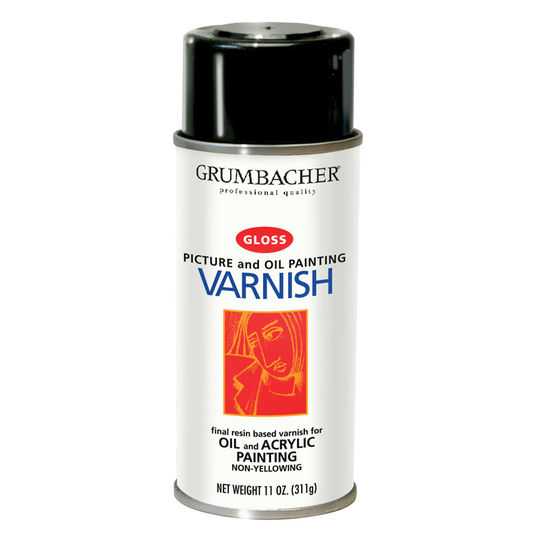 |
| The Best Spray-On and Best Overall |
Surprisingly, my new favorite varnish is a spray varnish. I never used to like spray varnishes because I felt they never really settled into the crevices of a painting very well, but Grumbacher’s Final Varnish Spray (Gloss) has changed my mind!
It coats really evenly, has great adhesion (even in oily areas), and takes multiple coats very well. I find it also evens the sheen of my paintings. Areas that are matte become glossy, but more unexpectedly, areas that I think are too glossy actually get matted slightly as a result of the fine aerosol texture.
I tend to apply this varnish in one moderate coat, going just barely heavier than I need, and then allow it to settle in. If needed, I can give it a second light misting, which binds to the first coat very well and does not matte out the surface as many other aerosols tend do.
 |
| The Worst Spray-On |
The worst spray varnish I tried was Krylon’s Conservation Varnish (Gloss). It beaded really badly in oily areas, and puddled up in the less oily areas, resulting in an incredibly uneven surface. Multiple coats did little to remedy this.
BRUSH-ON
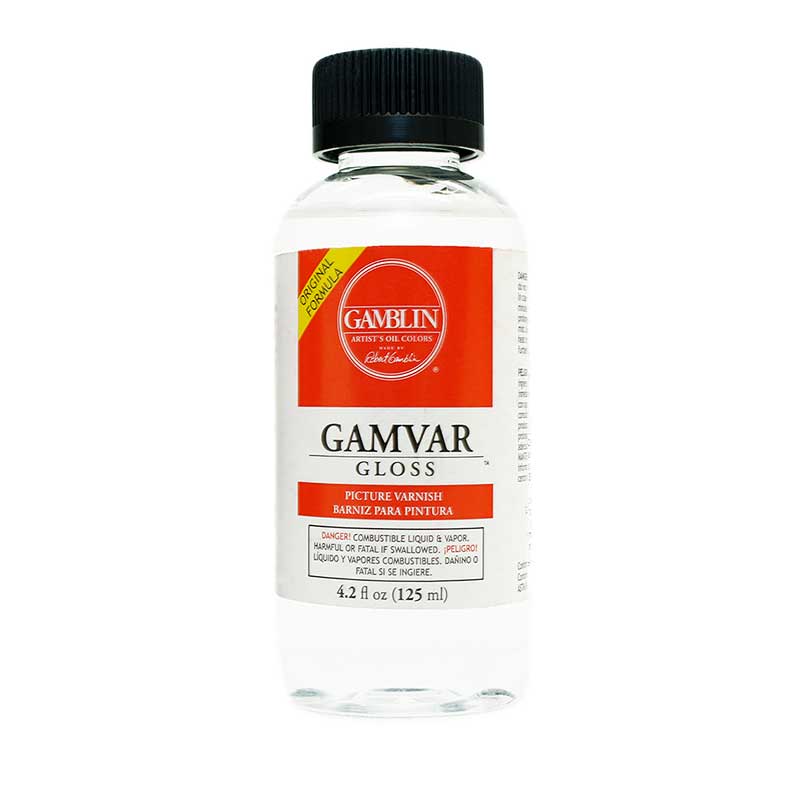 |
| The Best Brush-On |
As for Brush-on Varnishes, I’m still not as in love with any as much as the discontinued ‘Conserv-Art’, but if I have to choose a replacement, Gamvar does a pretty darn good job. If you’re looking for something versatile, with a strong emphasis on safety and archival ability, this is a good choice.
The only downside to Gamvar for me is it’s thinness. It simply makes your painting look wet again, but doesn’t even out the surface any. Many may like it for just this reason, but I personally prefer a little more viscosity and a more enamel-like finish. Galkyd Lite actually does a better job of this in my opinion, but is non-removable.
 |
| The Worst Brush-On |
By far, the worse varnish I tried was Weber’s Synvar. A final varnish is not supposed to chemically bond to paint film beneath it. But this varnish sticks to the surface so poorly, that just the moisture (or maybe the oils) in your hands will cause the varnish to peel off your painting like a bad sunburn. If you hold your painting in one spot for more than a minute, varnish will stick to your fingers instead of the painting. I would avoid this one at all costs. I found that the W&N brush-on varnishes do this to some extent too, but to a far lesser degree.


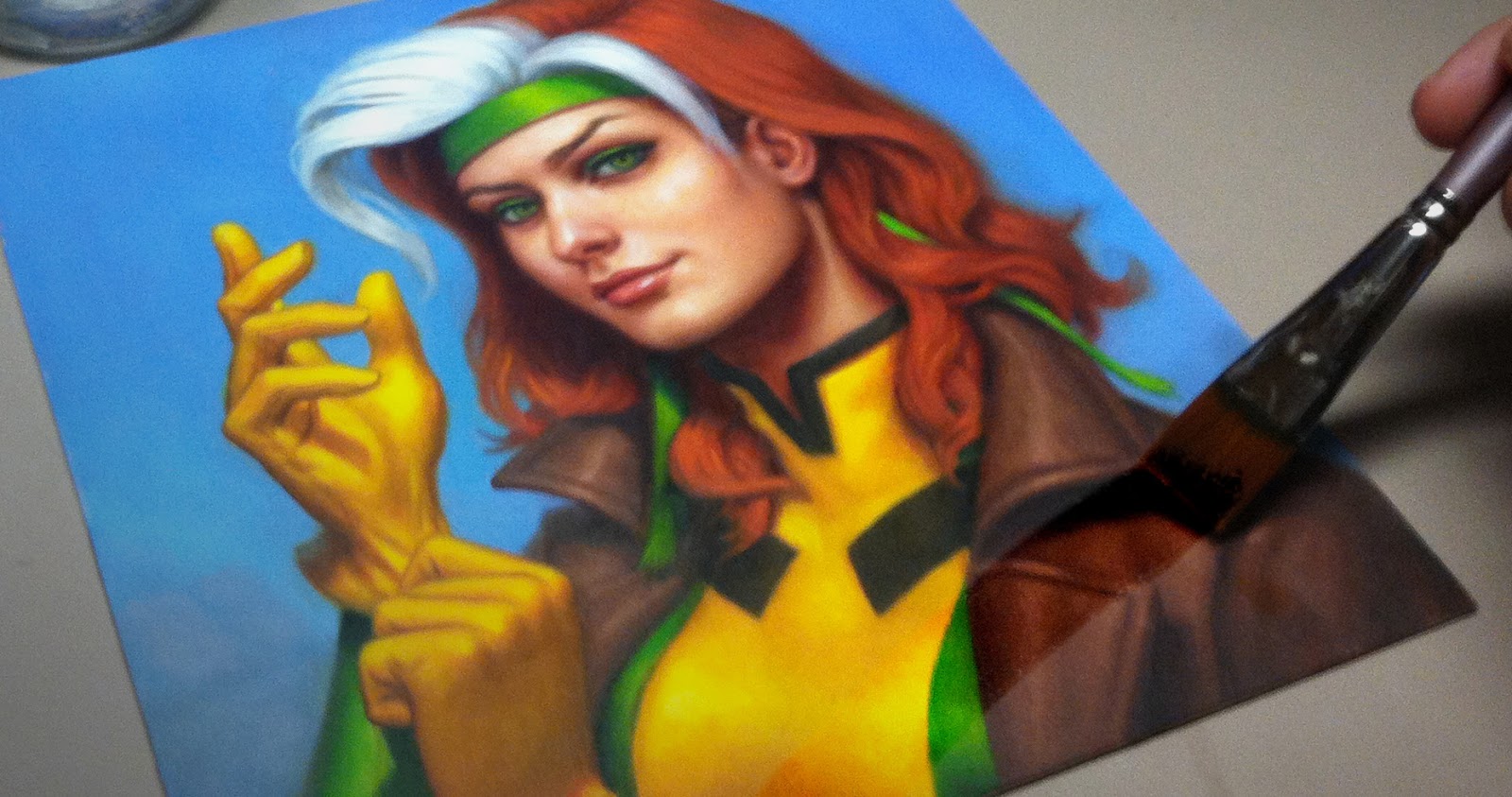

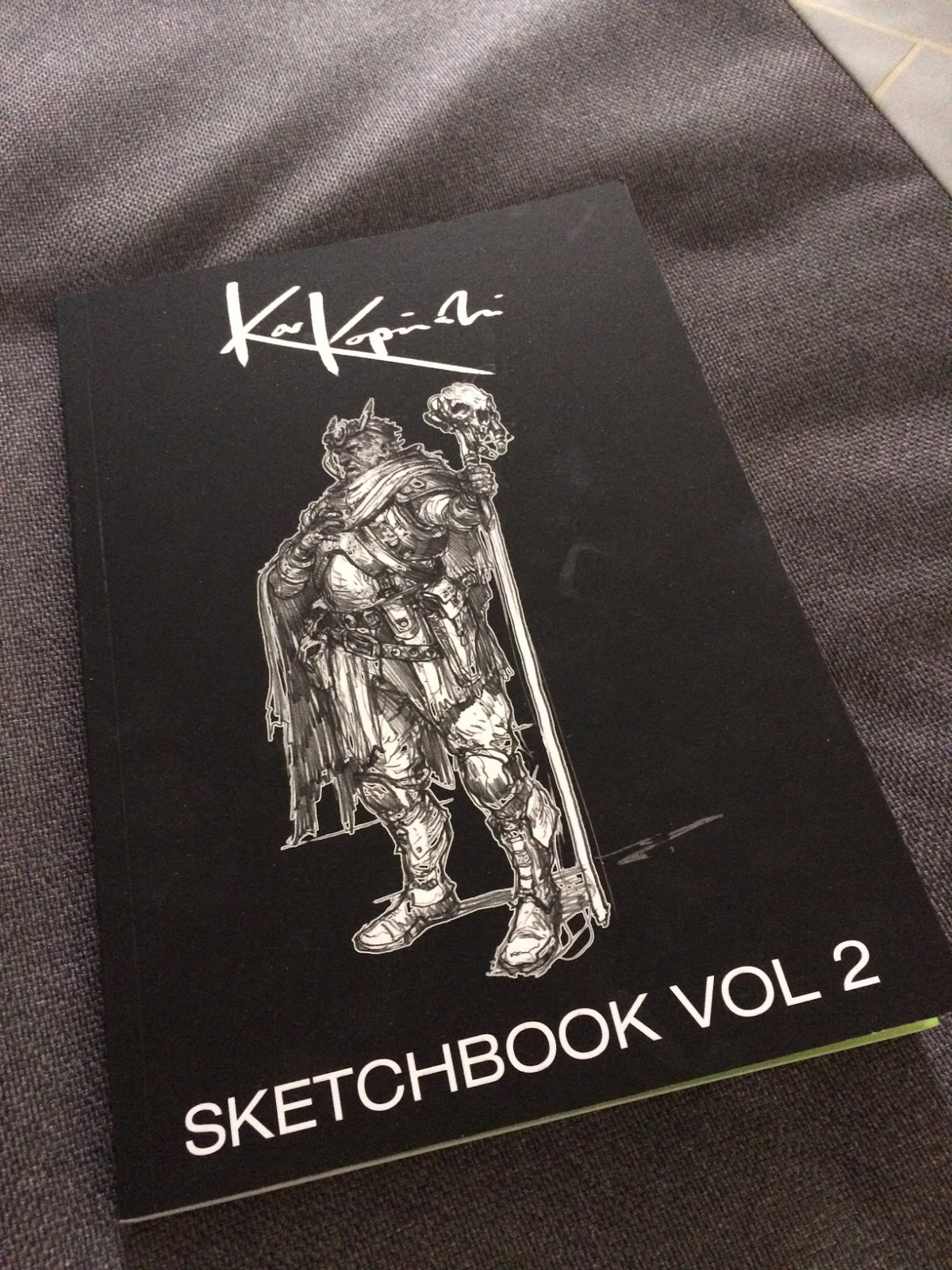
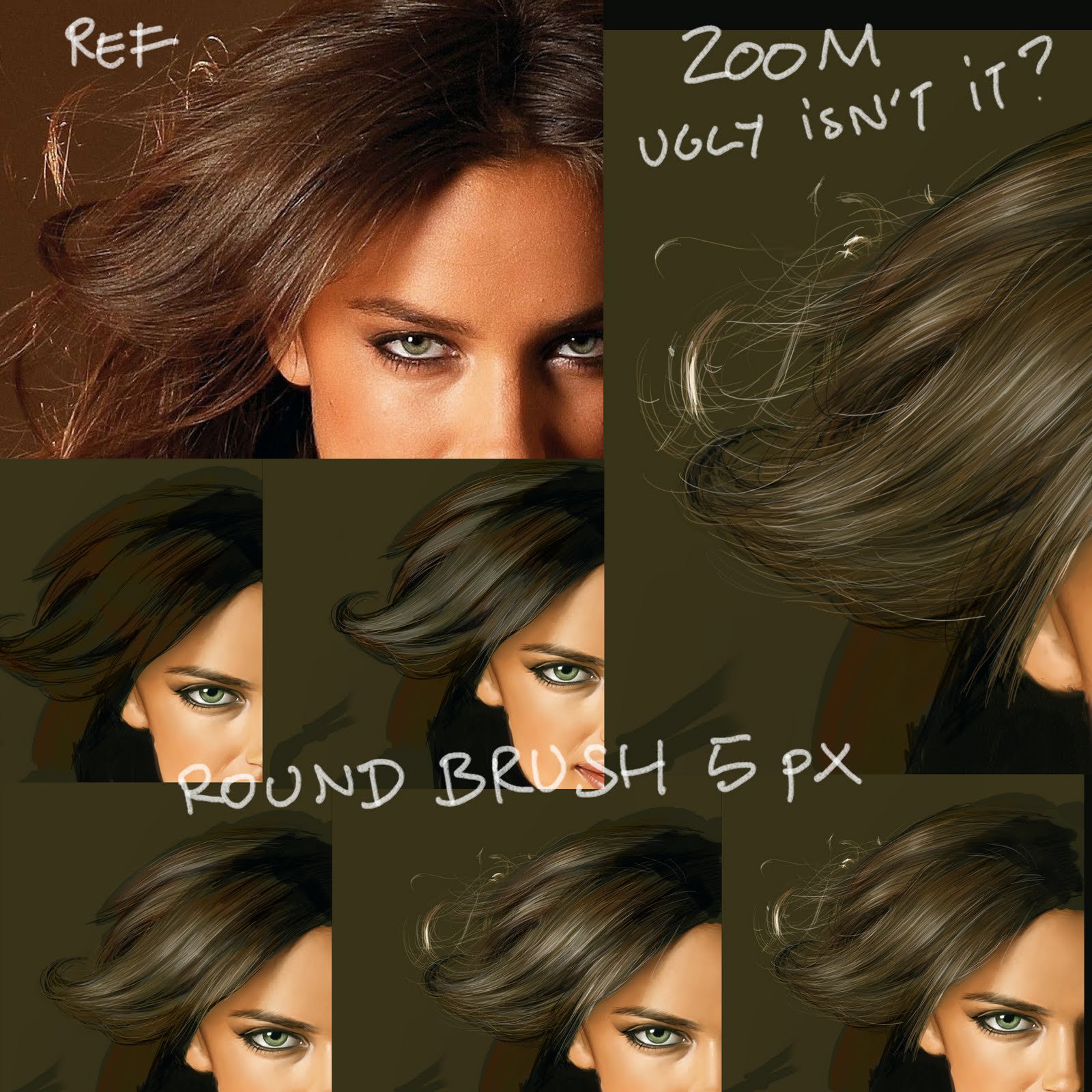


Great post Dan. I've had a lot of luck with Gamvar. I found the surface just a little too glossy for my tastes, but have been mixing in a small amount of Gamblin's cold wax medium to achieve a luster like surface that sits nicely between matte and glossy. There are some videos on Gamblin's site that show how to mix the cold wax medium into the varnish(super easy fwiw).
Great Post! Never tried spray vanishes (not a big fan of sprays) but might have to give your recommendation a try. One thing that is good about Galkyd as an evening out top coat is you can apply it when the paint is touch dry and not wait months after a painting is finished. Say if you have a con or something that you want to show off the painting. Though it is not a protective varnish it will do. Thanks for the reviews!
Yeah, ive been meaning to try adding a little wax in. I tried the Premixed. They now offer a satin finish as well that I haven't tried yet.
That the biggest benefits of a spray for me. Often times the small amount of solvent contained in a varnish will wipe away a layer of paint that may not have dried fully. But with a spray, I could toss it right on before a con.
I would like to apply a final varnish to my work, but for oil paintings, I've heard they take 6 months to a year to dry completely. I sell most of my work within a few weeks after completion. So, I just apply retouch varnish. Any solutions??
I was told gamvar varnish are designed to be used as soon as your oil paints are dry enough you can’t leave a dent when you press on your paint with your finger nail..like 2 weeks or so depending on your thickness of paint..
I agree with Sam. I use Gamvar with a little cold wax medium dissolved in and it gives just the right satin finish that I like. Be sure to mix up a large enough batch of varnish to cover the entire picture though, as the measuring of cold wax is an inexact process! I didn't once and had to recoat the entire picture to match the sheen.
Thank you for the thorough review! And perfectly timed too, as I'm starting to investigate varnishes for the paintings I did in summer. This really helped demystify the world of varnishes for a beginning oil painter like myself. One question I have, is what do you do if someone buys your painting and it's not completely dried yet for a final varnish?
Seidal, you can apply Gamvar as soon as the painting is dry to the touch (or your fingernail won't leave an indent in the paint film). The 6-month rule is somewhat arbitrary. If you paint with just turpentine washes, and add a drying agent, it's conceivable that your painting will be as dry as it can be within just a few weeks. The time frame needed depends greatly upon HOW you paint.
Gamvar can be applied as soon as it's dry to the touch. However, if it's still premature, I just do a coat of retouch. I then contact the client a year later and reapply a varnish them. It's also a good excuse to rekindle the relationship.
W&N Artists Matte and Gloss are the ones that have been discontinued. Or rather they dropped that formula and just started selling W&N Conserv-Art under the name “Artists Varnish”. I think they realized there was no point in having two formulas when one of them was so flawed.
Interesting! And as far as you know, it's the same exact formula as the conserv-art?
Yes, I used W&N Artists Varnish back when it would turn powdery if scratched. Because of that, I switched to Conserve-Art and loved it. When they discontinued Conserv-Art, I was surprised they would discontinue their good formula and keep their bad formula, so I wrote W&N to ask about it and they told me that they had dropped the old Artist Varnish formula and switched the name of Conserv-Art to Artists. I tried a new bottle of Artists, and it behaved exactly like Conserv-Art had. I've used it ever since.
Thanks! I will give it a try with Gamvar. Thanks for the tip!
Sweet! You just made my day, Rob!
How about mixing a little bit of Turpentine to it? I've been using a varnish which hasn't been mentioned in this post for years, and with that particular varnish, turpentine would subdue its glossiness a bit to my taste. I wonder it would do the same trick to Gamvar.
Can this “Artists Varnish” (aka: Conserve-Art) be applied when the painting is dry to the touch, like Gamvar?
Technically, you can always apply it when it's dry to the touch. It's just not archival. If the paint layer hasn't totally cured, the varnish will bind to it. So if someone removes that varnish, that last layer of paint will likely come off with it. If you never plan on removing it, then it's not an issue. The other problem is that varnish has solvent in it. If your painting is still a little wet, brushing on the varnish can cause it to wipe off some paint.
I need to try that W&N Artist varnish. I have been using Daniel Smith’s Gloss picture varnish, It can be a bit thick at times, but that’s probably for the best (to smooth out the canvas surface).
Great article Dan. Thank You for share with us.
Although I haven't tested or used all the products here as extensively as you have I have had no problems with the Krylon spray. I did not like the one you tested here either but their UV Archival Gallery Series has worked great for me. I don't like higher gloss finishes so I use the satin finish.
It is removable and chemically different than oil paint which conservators recommend.
I prefer sprays over brush-on for ease and uniformity of application and have sprayed paintings up to 24″ x 36″. After that a spray can won't do it.
I have also had to remove it from a small area of a painting and was able to do without any affecting the oil paint then respray… I actually sprayed one before I signed it, oops. I sign my work after it has dried and I am satisfied it is done, was in one of those deadline crunches for an upcoming show… well you know, it happens.
In fact I never understood anyone wanting high gloss. I am always annoyed by the glare off the surface whenever I am visiting a gallery, show or museum, especially on large works. It makes it too hard to see the painting without having to move my head back and forth to 'see around' the glare.
To my eye the same richness and depth is achieved with satin as with the higher gloss.
I guess its personal preference.
I do to try the best one for brush-on for larger works and this post helps.
Thanks
Fantastic post, Dan! Much appreciated as I inch my way back toward real paints again…
Good post Dan. Just don't try any of these with water colour! If any one has any ideas for one I could use on my “thick” water colour – I'd love some advice. It would have to be a spray, for as I found out once, trying to “brush” on a varnish is a big, big mistake.Because water colour (and gouache) always remains workable, it,s a real problem! Anyone any ideas?
Don't have an answer really but as an experiment you could try having a sample UV varnished at a printer. Its technically a sticky thin transparent foil that sets under a strong blast of UV light. It should not re-wet the paint but unsure if it will stick to uneven paint. Some pressure is also applied during the process.
Dan, do you varnish before or after photographing a painting?
Paul-
Are your Watercolors's Impasto? If so, i have no answer there. I paint with thin Watercolor and Acrylic Washes and have been sealing them with several coats of Krylon. I would say just paint a scrap piece of paper as a test and see which sealant works best-Cheers
Ahh, that's clever. And that's good to know that contacting the client a year later for the final varnish is acceptable. Very smart. Thank you!
I always varnish first, usually just a retouch though. For me, it's imperative for a good reproduction.
Paul, I might just go with good old Krylon Crystal Clear. It shouldn't re-activate your watercolors.
I've heard nothing but great things about Daniel Smith products. I should give their varnish a shot too.
Yeah, that glare in galleries is tough. I don't like it either. Partly it's due to too high of a gloss. But more times than not, I find it's due to poor lighting. Gallery lighting should come nearly straight down on a piece. When you have a light in the middle of a room shining at a wall, you're going to get glare no matter how matte your varnish is.
Dan, I just saw your edit in the main post about W&N Artists Varnish being different from the Matte and Gloss. But the old Artists Matte and Artists Gloss (the ones that scratch to white) are discontinued. They don't make them anymore. All three sheens currently available from W&N (Gloss, Satin, and Matte) are the Conserv-Art formula.
Nicolay, Michael and Dan! Thanks for the tips. I guess I should do one or two quick experiments on some old stuff. Maybe give that Krylon a go. It,s not really necessary, but I managed one once years ago…..brushed some Winsor and Newton varnish on and it looked beautiful! Just like an old master oil painting. “course – next time I tried it it ruined the painting………
PS Dan, why the Krylon instead of the Grumbacher?
I always try to seal with acrylic first, if possible. If seal it with acrylic (which crystal clear is), you can still put an oil varnish on top later. You can't do the opposite. Plus, Krylon Crystal clear is super predictable
Aaaaah! Thanks Dan.
Dan, I accidentally used stand oil (instead of linseed oil) and mineral spirits to oil in. I wiped it off but after weeks it's still really tacky. I've tried wiping off with mineral spirits and then turp to get the stickiness off but no avail. I've read direct sunlight might help or a Krylon Quick Dry spray. Any advice appreciated.
I've had that happen before. Stand oil can take a loooooong time to dry. Ideally, you should just leave it alone and wait. But you may not have time for that.
I haven't tried the Krylon Quick Dry yet, but I hear decent things.
You may also consider trying a retouch varnish (ideally a spray). It may bond with the stand oil, and help the oxidation process. It's possible it may still be a little tacky in the end, but I would assume LESS tacky than it is currently.
Wow! The video of the uneven varnish was like looking at a brochure with spot UV varnish … in all the wrong places!!! Terrible.
Thanks for sharing such an in-depth review!
This was a LOT of time, money and work for you. A very hearty THANK YOU for sharing!
I will need to try these out. Thank you for sharing these reviews.
I’ve tried many, and the only one that I’ve liked is, DecoArt Americana DuraClear Polyurethane Satin Varnish. Cheap brand, but it spreads so smoothly, dries fairly fast, and looks great. Does well with multiple coats, or just one ample coat. Supposedly it is permanent and non-yellowing. If you decide to test that brand out, I would love to hear your thoughts.
All the others I’ve used have been either sticky, bubbly, and or unable to spread without thinning.
Any polyurethane is the painting conservators nightmare. Please never us it on your painting unless you don’t care if your painting’s last.